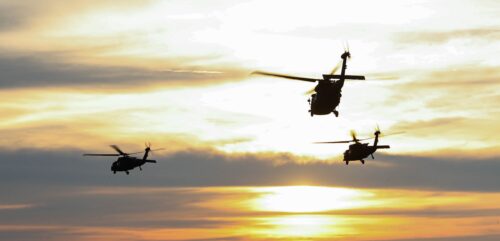The 101st Airborne Division (Air Assault) recently conducted a historic large-scale, long-range air assault (L2A2) mission, showcasing its enduring capabilities and commitment to innovation.

U.S. Army photo by Staff Sgt. Raymond Valdez
The operation, which involved over 3000 Soldiers assigned to the 2nd Mobile Brigade Combat Team “STRIKE” and 80 aircraft traveling over 500 miles from Fort Campbell, Ky., to Fort Johnson, La., was a significant departure from traditional brigade movements to the Joint Readiness Training Center (JRTC). Troops typically travel by ground and spend several days preparing before entering the combat scenario, but this mission involved a complex, long-range air assault that required meticulous planning and coordination. The troops and equipment made multiple stops at forward arming and refueling points (FARPs) scattered across multiple southern states.
U.S. Army Col. Travis McIntosh, the deputy commanding officer for support for the 101st Airborne Division (Air Assault), highlighted the complexity of the mission: “The legacy that we have, dating all the way back to World War II when we were an Airborne Division fighting in Europe, is that your 101st Airborne Division now is Air Mobile–it’s Air Assault, we have a number of helicopters. That’s how we fight in this division and we’re demonstrating that from Kentucky and Tennessee all the way down to Louisiana.”
The FARPs played a critical role in the success of the mission, providing essential logistical support for the troops and aircraft. These temporary refueling and rearming points allowed the aircraft to refuel and rearm quickly, enabling them to continue the mission without significant delays.
1st Lt. James Tate, a quartermaster officer with Echo Troop, 2nd Squadron, 17th Cavalry Regiment, 101st Combat Aviation Brigade, emphasized the importance of FARPs: “Our birds [aircraft] are able to come in get fueled, get armed and continue the fight. We can puddle hop across and get the birds further over a shorter period of time.”
The ability to conduct air assaults from long distances and into contested landing zones is a testament to the 101st Airborne Division’s adaptability and combat power. The division’s ability to operate at night and in challenging environments further demonstrates its expertise.
The mission was made possible by the support of local communities, airports, and National Guard locations, which provided essential logistical support for the troops and aircraft. This collaboration highlights the importance of community involvement in enabling large-scale military operations.
For more information, hit the Source below
I have to wonder if that division will officially change its name since it is no longer airborne? It is now airmobile, using helicopters instead of parachutes. Still a very effective fighting force, but different means of assault.